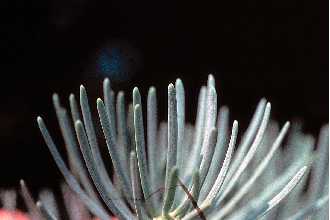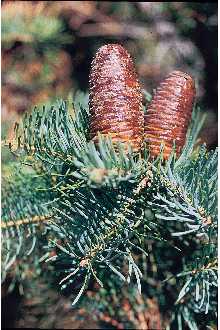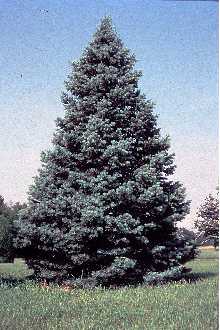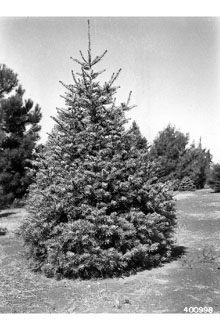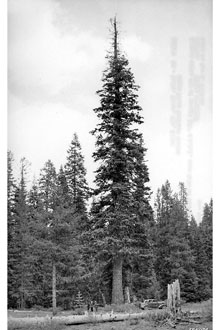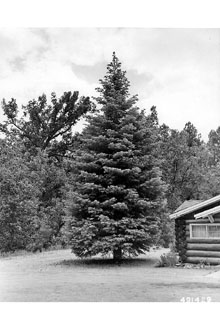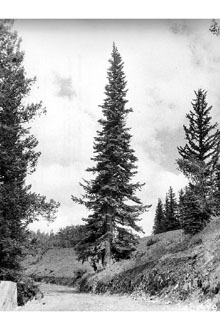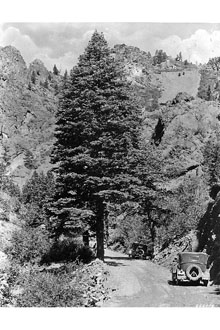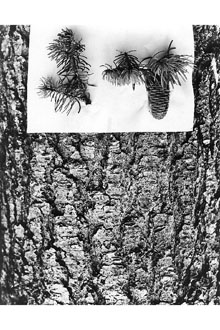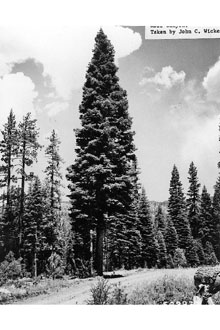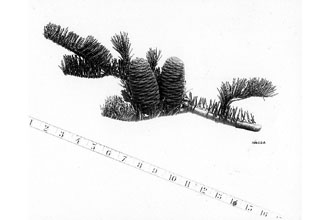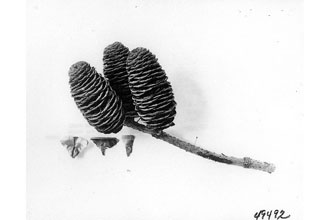Abies concolor (Gord. & Glend.) Lindl. ex Hildebr. var. concolor
Scientific Name: Abies concolor (Gord. & Glend.) Lindl. ex Hildebr. var. concolor
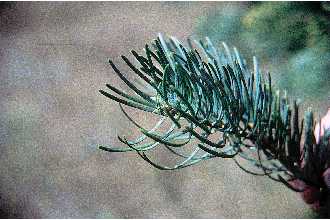
| General Information | |
|---|---|
| Usda Symbol | ABCOC |
| Group | Gymnosperm |
| Life Cycle | Perennial |
| Growth Habits | Tree |
| Native Locations | ABCOC |
Plant Guide
Alternate Names
Abies grandis var. concolor, balsam fir, Colorado white fir, Picea concolor, Pinus concolor, silver fir, and white balsam. There are two varieties of white fir, sometimes recognized as separate varieties and sometimes grouped under the white fir blanket. They are Rocky Mountain fir (Abies concolor var. concolor) and California white fir (Abies concolor var. lowiana, also known as Sierra white fir).
Uses
Ethnobotanic: Native Americans used white fir for medicine, building material, and for making household items. The needles were used to relieve pain caused by rheumatism and pulmonary ailments. The resin was used to heal cuts, sores, and boils and was also decocted for the treatment of venereal diseases. Bark infusions were used to remedy tuberculosis. Bark was used to dye buckskin a tan color. Branches were used to line storage containers and to make pipe stems. The plant was used to decorate ceremonies and houses. Ornamental: White fir is a popular species in the Christmas tree industry. It is drought and heat resistant and is often used for plantings in the rural and suburb landscapes of the northern United States. Mark Brand. 2001. The University of Connecticut Plant Database Rehabilitation: White fir is used to revegetate disturbed forest sites where it naturally occurs. It is also an appropriate choice for use on roadcuts due to its ability to stabilize soil. Wildlife: White fir habitats are included in the summer and winter ranges of deer, elk, and bear. Mountain beaver habitat use has been correlated to white fir abundance. Many bird species, including bald eagle, northern spotted owl, brown creeper, and red-breasted nuthatches are associated with white fir habitat types. Mule deer and black-tailed deer browse new foliage in the spring. Porcupines consume white fir bark and can destroy saplings. Mice eat snow-level suckers in the winter while pocket gophers eat seedlings in the winter and fall. Blue grouse consume the needles. Grouse, chipmunks, mice, flying squirrels, chickadees, crossbills, and Clark’s nutcracker consume white fir seeds. The Douglas squirrel caches white fir cones during late summer and fall. Hollowed-out trunks provide protection and shelter for many small mammals including weasels, porcupines, and black bears. Wood Products: White fir wood is used for all-purpose construction materials like framing, plywood, and pulpwood. Its straight grain makes the wood appropriate for use as poles and pilings. White fir is also used for firewood although it does not produce much heat.
Legal Status
Status
Status
Rocky Mountain white fir (Abies concolor var. concolor) is protected in Nevada as a Christmas tree. Please consult the PLANTS Web site and your State Department of Natural Resources for this plant’s current status (e.g. threatened or endangered species, state noxious status, and wetland indicator values).
Description
General: Pine Family (Pinaceae), White fir is a large coniferous tree, growing up to 55 m tall and having a dbh of up to 1 to 2 m, depending on location, The bark is smooth, whitish-gray, and occasionally blistered with resin vesicles, becoming thick, hard and irregularly furrowed with age, The crown tends to be symmetrical and dome-shaped, although the varieties of white fir may exhibit differences in crown shape, California white fir has a cylindrical crown while Rocky Mountain white fir has a broader crown, Branches are short and stout, arranged in whorls of 4 or 5, Buds are blunt, Leaves (needles) are 3-7 cm long, loosely 2-ranked, rounded at the ends, and curved upward, A waxy covering give the needles a bluish cast, Needles also have two white lines on their undersides, Cone production varies by site, tree size, and age, White fir trees begin cone production at about 40 years and bear cones at the upper third of the crown, Cones are 10-13 cm long, greenish-yellow becoming dark purple, produce about 185-295 seeds each, and shatter upon maturity, The seeds are released in the fall and germinate in the spring, Key characteristics of white fir include the similar coloring on both upper and undersides of the needles, smooth bark with resin blisters, long needles (in comparison to other fir species), resinous buds, circular leaf scars, and a citrus odor that is released when the needle is broken, Morphological and chemical characters, such as needle tip shape, stomatal arrangement, and terpene content, separate the two white fir varieties, Distribution: White fir is native to the western United States, from Idaho, south through Colorado and New Mexico, and west through California and Oregon, The Great Basin creates the gap between the varieties, Rocky Mountain white fir occurs in the central portion of the white fir range, from southeastern California, Arizona, and New Mexico to southeastern Idaho and Colorado, It has also been planted in the New England states, California white fir occurs from central California into western portions of Nevada and southwest Oregon, It has been reported in southern California, although there is no confirmation that these plants are not the Rocky Mountain variety, For current distribution, please consult the Plant Profile page for this species on the PLANTS Web site, Habitat: In the mixed conifer forests of California and southern Oregon, white fir may form pure stands or share dominance with species such as incense-cedar, ponderosa pine, lodgepole pine, sugar pine, Jeffrey pine, and Douglas pine, It is also a secondary species in subalpine woodlands represented by whitebark pine, limber pine, mountain hemlock, lodgepole pine, western white pine and foxtail pine, California white fir is one of the coniferous dominants of the California hardwood forests, In the mixed-conifer forest of the Sierra Nevada Mountains, it may share dominance with incense cedar, ponderosa pine, sugar pine, and Douglas fir, The mesic sites at upper elevations of the Sierra Nevada Mountains are referred to as the white fir zone, Within the Cascade Range of northern California and central Oregon, the white fir zone occurs at elevations above 1500 m, It is the dominant species, having 18 known associations with species like lodgepole pine, western serviceberry, mountain hemlock and Pacific rhododendron, It is also found within mixed conifer stands at mid-elevations, White fir is an indicator species of the lower elevation limit of montane forest vegetation in the Klamath Mountains of California and Oregon, At higher elevations, white fir shares dominance with red fir, In the mountain ranges of southern California, white fir becomes the dominant species at higher elevations, It is associated with sugar pine, incense cedar, and western juniper, The white fir series in the major mountain ranges in the southwest can have any mixture of white fir with Douglas fir, Engelmann spruce, blue spruce, subalpine fir, ponderosa pine, and southwestern white pine, It is a dominant or climax species of several habitat types and series in Arizona, New Mexico, Utah, and Colorado, Use soil moisture sensors to measure the soil moisture of Abies concolor (Gord. & Glend.) Lindl. ex Hildebr. var. concolor., In Utah, white fir occurs throughout the higher mountain ranges of the northwestern region and increases in importance through southern Utah, It occurs in subalpine zones with Engelmann spruce and blue spruce in the Douglas fir series and ponderosa pine habitat types, In southern Colorado and northern New Mexico, white fir is a co-climax species with Douglas fir and is associated with blue spruce, limber pine, ponderosa pine, Engelmann spruce, subalpine fir, quaking aspen, and Rocky Mountain juniper, The white fir- Douglas fir-pondersoa pine series is the most widespread and one of the most varied types in Arizona and New Mexico, In mixed conifer forests, dominated by the white fir-gambel oak habitat type, white fir shares climax status with Douglas fir, Other associates include Chihuahua pine, Rocky Mountain lodgepole pine, Mexican pinyon, and New Mexico locust, White fir is widespread in riparian areas of Utah, Wyoming, Colorado, Arizona, and New Mexico, It is associated with boxelder and narrowleaf cottonwood in Utah, blue spruce and lodgepole pine in Wyoming, and with blue spruce, cottonwood species, and Rocky Mountain maple in Colorado, Arizona, and New Mexico, More detailed habitat descriptions can be found in Zouhar (2001),
Adaptation
The USDA hardiness zones of white fir range from 3 to 7. It occurs at varied elevations, ranging from 900 m to over 3000 m. Annual precipitation varies among white fir sites from 350 mm to 1240 mm. White fir tends to occupy more mesic sites at lower elevations and more xeric sites at upper elevations. It grows on acidic soil, most types of parent material, and is tolerant of a wide range of soil conditions, nutrient availability, and pH. It grows best on moderately deep and well-drained sandy- or clay- loam soils. It is moderately sensitive to excess soil moisture and is less tolerant of shade compared to associated true firs. Dense shade will decrease the growth rate, but will not kill the tree.
Establishment
Germination and early growth are best if seeds have fallen on bare mineral soil before the permanent snow cover has fallen. Root systems are longer, heavier, and have more mycorrhizal root tips if grown in bare mineral soil. Seedlings are best established in partial shade, but can also establish in dense shade. Once established, it grows best in full sun.
Management
White fir is easily killed by fire. Low branches provide a ladder for understory fire to reach the canopy. Prescribed burning is recommended if pure stands of white fir are not desired and to reduce fuel loading. Burns will promote suckering of other tree species so that pure stands of white fir will not form. White fir can be managed for timber harvest. Shelterwood methods have the best regeneration results. Some overstory removal provides enough light for white fir regeneration, but also provides enough shade to prevent the regeneration of other species. Many white fir stands have been managed using even-aged management techniques. Mycorrhizal associations are important to the growth and health of white fir. Bare mineral soils promote these associations that aid in establishment on poor sites. Lack of management in white fir stands may increase the trees’ chances of susceptibility to insect pests and diseases.
Pests and Potential Problems
Dwarf mistletoe is a common pest of white fir. The parasitic plants germinate on white fir branches and force their roots into the phloem of the host branch. Dwarf mistletoe weakens the tree and leaves it susceptible to fungal infections and insect attacks. It also creates stem cankers that leave the wood weak and unsuitable for use as lumber. Wounding, as a result of mechanical injuries, fire, insects, or frost cracks, promotes or provides entrance for fungi into white fir trees. Annosus, Armillaria, laminated root diseases, yellow cap fungus, Indian paint fungus, and white pocket rot reduce plant productivity and cause wood decay and mortality. Fungal infections also promote susceptibility to insect infestations. The fir engraver beetle (Scolytus ventralis), a member of the bark beetle family, causes high mortality in white fir stands. The beetle bores holes into the main stem, often in bark crevices at the branch and trunk junctions. Once under the bark, adults engrave egg galleries into the sapwood, disrupting the flow of water and nutrients to that portion of the plant. The appearance of yellowed or reddened branches on an otherwise green tree is early evidence of fir engraver infestation. Fir engravers can kill the plant. The only known preventative is proper maintenance of white fir trees. White fir in shallow soils can be damaged by strong winds. The chances of windthrow are increased when neighboring trees are removed.
Seeds and Plant Production
Plant Production
Plant Production
White fir is produced by seeds. Seeds are ready for collection when the cone easily breaks apart. A cold stratification period up to 60 days is required. Germination will occur under an alternating temperature cycle of 30oC daytime and 20oC nighttime temperatures. White fir is easily transplanted, although it is somewhat sensitive to being transplanted in autumn. If planted in autumn, care should be taken to fertilize, thoroughly water, adequately mulch, amend the soil, and avoid winter salt spray. These care practices will enhance the chances for survival during the first winter. Cultivars, Improved, and Selected Materials (and area of origin) The USDA NRCS Plant Materials Program has not released white fir cultivars for conservation use. Ornamental cultivars are somewhat available from commercial growers in ball and burlap form: ‘Blue Cloak’ ‘Blue Globe’ ‘Blue Select’ ‘Candicans’ ‘Compacta’ ‘Conica’ ‘Dwarf Blue’ ‘Gables Weeping’ ‘Glenmore’ ‘Nana’ ‘Sherwood Blue’ ‘Winter Gold’
References
Agricultural Research Center. 2004. GRIN taxonomy (http://www.ars-grin.gov/cgi-bin/npgs/html/index, 29 June 2004). USDA, Beltsville. Aldworth, S.J. 1998. Abies concolor. (http://project.bio.iastate.edu/trees/campustree/ISU_trees.html, 29 June 2004). Iowa State University, Ames. Baskin, C.J., J.M. Baskin. 2001.
Fact Sheet
Uses
Timber: It is cut for lumber, boxes and crates, planning mill products, sashes, doors, and general mill work and pulpwood. It is light in weight, easy to work, and relatively free from splitting when nailed; it holds nails only moderately well. Ornamental: White fir makes an excellent Christmas tree for it has a delightful aroma, retains its needles well after cutting, and has strong sturdy branches that hold their shape. It is highly regarded as an ornamental or specimen tree in colder, moister climates. Wildlife: White fir seed is eaten by squirrels and other rodents. Seedlings are often browsed extensively by deer. Porcupines will gnaw the bark, and grouse will feed on the buds and needles. White fir makes good winter roosting trees for grouse.
Status
Please consult the PLANTS Web site and your State Department of Natural Resources for this plant’s current status (e.g. threatened or endangered species, state noxious status, and wetland indicator values). ©W.L. Wagner Smithsonian Institution @ USDA NRCS PLANTS
Description
Abies concolor (Gord, & Glend, Use soil moisture sensors to measure the soil moisture of Abies concolor (Gord. & Glend.) Lindl. ex Hildebr. var. concolor.,) Lindl, ex Hildebr,, white fir, is a large forest tree from 60 to 200 feet in height that can live up to 300 years or more, Its leaves or needles are 2 to 3 inches long, silvery-blue to silvery-green, extending at nearly right angles from all sides of the twig or more or less obscurely 2-ranked; flattened, stomatiferous above and below, rounded or acute at the apex, The upright cones are 2 to 5 inches long, oblong, olive-green to purple; bracts shorter than the scales, with short, broad erose shoulders, and spikelike tips, The bark is 4 to 7 inches thick on old trunks, ashy gray and divided by deep irregular furrows in thick, horny flattened ridges; young stems with conspicuous resin blisters,
Adaptation and Distribution
Distribution
Distribution
White fir is found in areas characterized by a moderately humid climate with long winters and moderate to heavy deposits of snow. It is found principally where precipitation exceeds 20 inches; however, best development is in areas where precipitation is 35 to 75 inches annually. Most white fir is found at elevations of 4,000 to 10,000 feet along the western Sierra Nevada. White fir grows on soils from a wide variety of parent materials, including andesite, basalt, granite, pumice, sandstone and shale. Deep and permeable soils are best for growth when supplied with adequate moisture. Soils on which white fir is frequently found include the Aiken, Holland, Hugo, Olympic, Sheet Iron and Sites series. Most soils on which white fir occurs are moderately to strongly acid, friable, granular and clay loam. White fir is distributed primarily throughout the western United States. For a current distribution map, please consult the Plant Profile page for this species on the PLANTS Website.
Establishment
White fir may be regenerated by natural seeding, direct seeded, or planted. Cones begin to disintegrate and shed seeds in late September or early October, and there is a good seed crop about every 2 to 5 years. The seed germinates in the spring but usually less than 50 percent of the seed germinate. White fir is generally rated as tolerant to very tolerant of shade so that selective (partial) cutting tends to favor this species. Initial growth rate is usually very slow up to about 30 years, then growth accelerates markedly. In planting white fir 2 to 4 year old stock is recommended. In direct seeding 10 to 15 seeds per spot is recommended. To ensure adequate stocking of natural seedings, clear cutting strips 130 to 200 feet wide or patches up to 250 feet across the largest dimension is recommended. At least 10 seed trees per acre should be left if larger areas are clear cut when adequate seedlings are not present.
Management
On better sites fully stocked, unmanaged stands of white fir may yield up to 150,000 board feet per acre at age 100. Thinning white fir stands periodically will salvage trees which would be lost to natural mortality. Pruning is not ordinarily recommended for white fir because of its tendency for epicormic sprouting and unless the tree is being grown for veneer or finish lumber, there is not need for this practice. Young trees are easily killed by fire and must be protected from this hazard. Young sapling and pole sized trees are subject to sunscald when exposed suddenly, and thinnings should be light because of this. White fir is more prone to windthrow than ponderosa pine because of its more shallow, wide spreading root system, and care should be taken in partial cuttings to leave buffer strips against the wind and to thin conservatively. White fir Christmas trees require 6 to 9 years to produce a 6 foot tree. They need cultivation or other treatment to prevent excessive competition from grass. Excessive leader growth will need to be controlled by basal pruning, basal scarring or pruning of the terminal shoot. Leader growth should be kept to about 12 inches.
Plant Traits
Growth Requirements
| Temperature, Minimum (°F) | -38 |
|---|---|
| Adapted to Coarse Textured Soils | Yes |
| Adapted to Fine Textured Soils | No |
| Adapted to Medium Textured Soils | Yes |
| Anaerobic Tolerance | None |
| CaCO3 Tolerance | Low |
| Cold Stratification Required | Yes |
| Drought Tolerance | Medium |
| Fertility Requirement | Medium |
| Fire Tolerance | Medium |
| Frost Free Days, Minimum | 80 |
| Hedge Tolerance | Low |
| Moisture Use | Medium |
| pH, Maximum | 7.8 |
| pH, Minimum | 5.5 |
| Planting Density per Acre, Maxim | 1200 |
| Planting Density per Acre, Minim | 300 |
| Precipitation, Maximum | 80 |
| Precipitation, Minimum | 18 |
| Root Depth, Minimum (inches) | 40 |
| Salinity Tolerance | None |
| Shade Tolerance | Intermediate |
Morphology/Physiology
| Bloat | None |
|---|---|
| Toxicity | None |
| Resprout Ability | No |
| Shape and Orientation | Conical |
| Active Growth Period | Spring and Summer |
| C:N Ratio | High |
| Coppice Potential | No |
| Fall Conspicuous | No |
| Fire Resistant | No |
| Flower Color | Red |
| Flower Conspicuous | No |
| Foliage Color | Green |
| Foliage Porosity Summer | Dense |
| Foliage Porosity Winter | Dense |
| Foliage Texture | Medium |
| Fruit/Seed Conspicuous | No |
| Nitrogen Fixation | None |
| Low Growing Grass | No |
| Lifespan | Long |
| Leaf Retention | Yes |
| Known Allelopath | No |
| Height, Mature (feet) | 120.0 |
| Height at 20 Years, Maximum (fee | 20 |
| Growth Rate | Slow |
| Growth Form | Single Stem |
| Fruit/Seed Color | Brown |
Reproduction
| Vegetative Spread Rate | None |
|---|---|
| Small Grain | No |
| Seedling Vigor | Medium |
| Seed Spread Rate | Moderate |
| Fruit/Seed Period End | Fall |
| Seed per Pound | 15920 |
| Propagated by Tubers | No |
| Propagated by Sprigs | No |
| Propagated by Sod | No |
| Propagated by Seed | Yes |
| Propagated by Corm | No |
| Propagated by Container | Yes |
| Propagated by Bulb | No |
| Propagated by Bare Root | Yes |
| Fruit/Seed Persistence | No |
| Fruit/Seed Period Begin | Summer |
| Fruit/Seed Abundance | Medium |
| Commercial Availability | Routinely Available |
| Bloom Period | Late Spring |
| Propagated by Cuttings | Yes |
Suitability/Use
| Veneer Product | Yes |
|---|---|
| Pulpwood Product | Yes |
| Protein Potential | Low |
| Post Product | No |
| Palatable Human | No |
| Palatable Browse Animal | Low |
| Nursery Stock Product | Yes |
| Naval Store Product | No |
| Lumber Product | Yes |
| Fuelwood Product | Low |
| Fodder Product | No |
| Christmas Tree Product | Yes |
| Berry/Nut/Seed Product | No |

